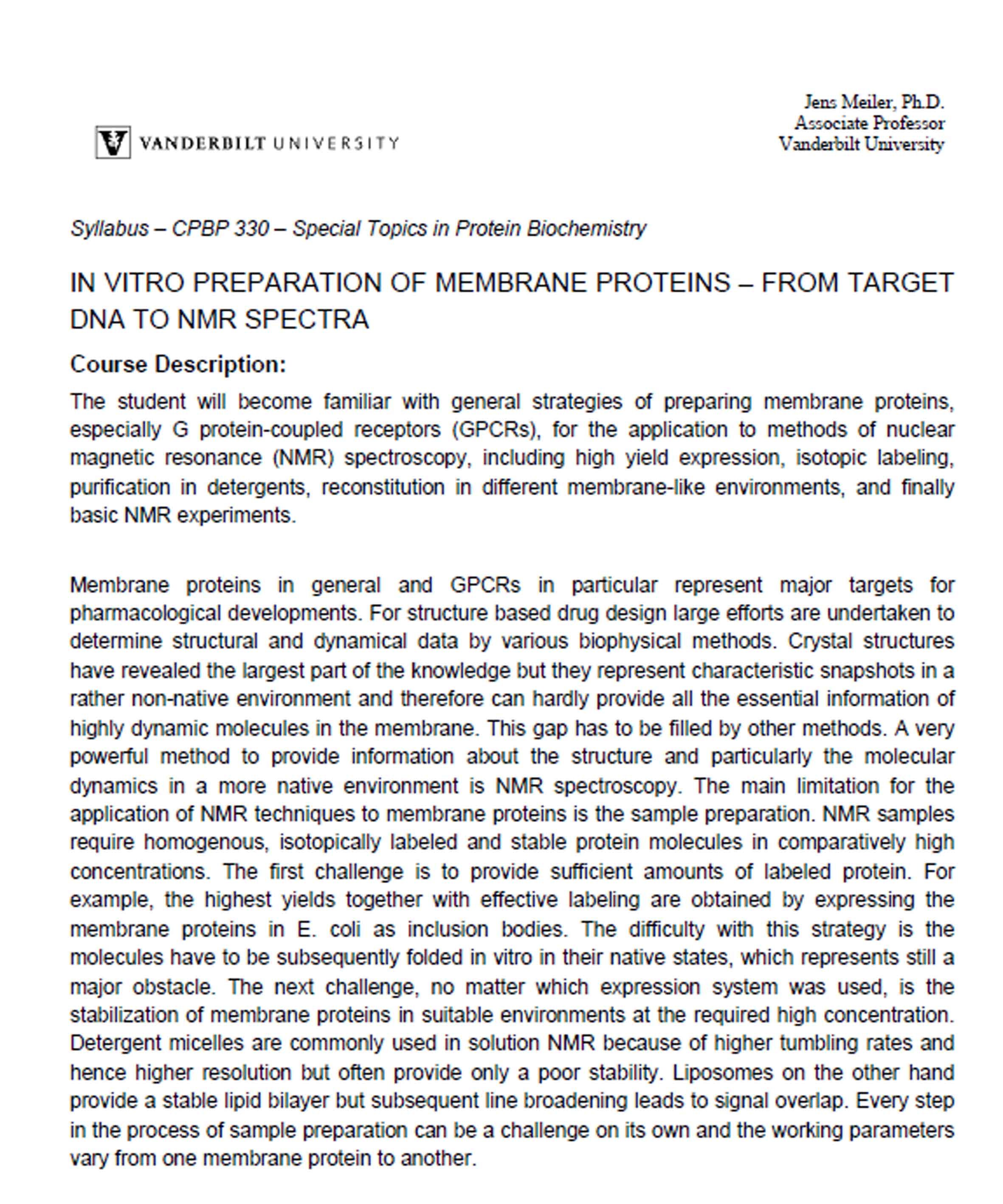Course on “In vitro Preparation of Membrane Proteins – from Target DNA to NMR Spectra” at Vanderbilt University
Graduate Course – Special Topics in Protein Biochemistry
Dr. Peter Schmidt, Leipzig University, Faculty of Medicine, Institute for Medical Physics and Biophysics
Date
The class will meet on six days in July always 9:35-12:15. Dates will be finalized with class participants. This is a one credit course.
Venue
Departments of Chemistry, Pharmacology, and Biomedical Informatics, Center for Structural Biology, and Institute of Chemical Biology, 465 21st Ave South, BIOSCI/MRBIII, 5131 MRBIII, Nashville, TN 37232-8725
List of Topics:
– Introduction into genetic engineering and recombinant expression (1h)
– Membrane proteins, GPCRs, and Y receptors (1h)
– Host systems for recombinant membrane protein expression and fermentation process (2h)
– Isolation and purification of membrane proteins (1h)
– Artificial membrane environments (1h)
– In vitro folding and reconstitution of membrane proteins (1h)
– Activity assays at different concentrations (1h)
– Labeling membrane proteins for NMR spectroscopy (1h)
– Basic introduction into NMR spectroscopy and product operators (2h)
– 1D-, 2D-, and 3D-NMR (1h)
– NMR experiments: HSQC, DQF, PDSD, a.o. (3h)
Registration
Students who wish to take the class for credit should register as soon as possible! Students, postdocs, and faculty who wish to audit the class are welcome. Please send a note to Jens Meiler ().
Grading
There will be a written exam at the end of class.
Course Description
The student will become familiar with general strategies of preparing membrane proteins, especially G protein-coupled receptors (GPCRs), for the application to methods of nuclear magnetic resonance (NMR) spectroscopy, including high yield expression, isotopic labeling, purification in detergents, reconstitution in different membrane-like environments, and finally basic NMR experiments.
Membrane proteins in general and GPCRs in particular represent major targets for pharmacological developments. For structure based drug design large efforts are undertaken to determine structural and dynamical data by various biophysical methods. Crystal structures have revealed the largest part of the knowledge but they represent characteristic snapshots in a rather non-native environment and therefore can hardly provide all the essential information of highly dynamic molecules in the membrane. This gap has to be filled by other methods. A very powerful method to provide information about the structure and particularly the molecular dynamics in a more native environment is NMR spectroscopy. The main limitation for the application of NMR techniques to membrane proteins is the sample preparation. NMR samples require homogenous, isotopically labeled and stable protein molecules in comparatively high concentrations. The first challenge is to provide sufficient amounts of labeled protein. For example, the highest yields together with effective labeling are obtained by expressing the membrane proteins in E. coli as inclusion bodies. The difficulty with this strategy is the molecules have to be subsequently folded in vitro in their native states, which represents still a major obstacle. The next challenge, no matter which expression system was used, is the stabilization of membrane proteins in suitable environments at the required high concentration. Detergent micelles are commonly used in solution NMR because of higher tumbling rates and hence higher resolution but often provide only a poor stability. Liposomes on the other hand provide a stable lipid bilayer but subsequent line broadening leads to signal overlap. Every step in the process of sample preparation can be a challenge on its own and the working parameters vary from one membrane protein to another.
The course will work through the pipeline of membrane protein preparation from a more practical point of view and will discourse bottle necks and possible ways to overcome these. In detail will be discussed 1) high-density fed-batch fermentation process of E.coli cells for high yield protein production, including labeling strategies for uniform isotopically labeled protein; 2) solubilisation and purification of the target proteins from cell membranes and inclusion bodies; 3) advantages and disadvantages of different detergent/phospholipid environments like micelles, bicelles and liposomes and how to exchange membrane proteins from one environment into another; 4) In vitro folding of membrane proteins in the presence of different environments – what has to be taken care of and how to test functionality; 5) how to concentrate and set up the samples for solution or solid-state NMR. Basic NMR experiments will be briefly described to show what data can be obtained from and how the samples have to be prepared for each experiment. Several examples will be taken from studies on GPCRs.

